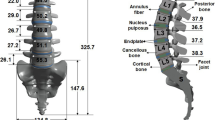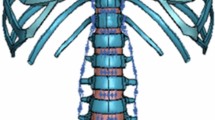Abstract
The purpose of this study was to (1) develop a three-dimensional, nonlinear pediatric lumbar spine finite element model (FEM), and (2) identify the mechanical reasons for the posterior apophyseal bony ring fracture in the pediatric patients. The pediatric spine FE model was created from an experimentally validated three-dimensional adult lumbar spine FEM. The size of the FEM was reduced to 96% taking into account of the ratio of the sitting height of an average 14-years-old children to that of an adult. The pediatric spine was created with anatomically specific features like the growth plate and the apophyseal bony ring. For the stress analyses, a 10-N m moment was applied in all the six directions of motion for the lumbar spine. A preload of 351 N was applied which corresponds to the mean body weight of the 14-years-old group. The stresses at the apophyseal bony ring, growth plate and endplate were calculated. The results indicate that the structures surrounding the growth plate including apophyseal bony ring and osseous endplate were highly stressed, as compared to other structures. Furthermore, posterior structures in extension were in compression whereas in flexion they were in tension, with magnitude of stresses higher in extension than in flexion. Over time, the higher compression stresses along with tension stresses in flexion may contribute to the apophyseal ring fracture (fatigue phenomena).








Similar content being viewed by others
References
Arlet V, Fassier F (2001) Herniated nucleus pulposus and slipped vertebral apophysis. In: Weinstein SL (eds) The pediatric spine. Lippincott Williams & Wilkins, Philadelphia, pp 453–469
Goel VK, Lim T-H, Gwon J et al (1991) Effects of rigidity of an internal fixation device—a comprehensive biomechanical investigation. Spine 16(Suppl):S155–S161
Goel VK, Monroe BT, Gilbertson LG et al (1995) Interlaminar shear stresses and laminae separation in a disc: finite element analysis of the L3-4 motion segment subjected to axial compressive loads. Spine 20:689–698
Goel V, Grauer J, Patel T et al (2005) Effects of Charite artificial disc on the implanted and adjacent spinal segments mechanics using a hybrid testing protocol. Spine 30:2755–2764
Ikata T, Morita T, Katoh S et al (1995) Lesions of the lumbar posterior end plate in children and adolescents. An MRI study. J Bone Joint Surg [Br] 77:951–955
Kajiura K, Katoh S, Sairyo K et al (2001) Slippage mechanism of pediatric spondylolysis: biomechanical study using immature calf spines. Spine 26:2208–2212
Kong W-Z, Goel VK (2003) Ability of the finite element models to predict response of the human spine to sinusoidal vertical vibration. Spine 28:1961–1967
Konz RJ, Goel VK, Grobler LJ et al (2001) The pathomechanism of spondylolytic spondylolisthesis in immature primate lumbar spines in vitro and finite element assessments. Spine 26:E38–E49
Sairyo K, Scifert J, Goel VK et al (1998) Neurocentral synchondrosis fracture in immature spines associated with pedicle screw type fixation devices. J Spinal Disord 11:142–145
Sairyo K, Goel VK, Grobler LJ et al (1998) The pathomechanism of isthmic lumbar spondylolisthesis. A biomechanical study in immature calf spines. Spine 23:1442–1446
Sairyo K, Katoh S, Ikata T et al (2001) Development of spondylolytic olisthesis in adolescents. Spine J 1:171–175
Sairyo K, Biyani A, Goel VK et al (2005) Pathomechanism of hypertrophy of ligamentum flavum: a multidisciplinary investigation by clinical, biomechanical, histological and biological assessment. Spine 30:2649–2656
Sakamaki T, Katoh S, Sairyo K (2002) Normal and spondylolytic pediatric spine movements with reference to instantaneous axis of rotation. Spine 27:141–145
Sucato DJ. (2004) Back pain in children and adolescents. In: Frymoyer JW, Wiesel SW (eds) The adult and pediatric spine, vol 1. Lippincott Williams & Wilkins, Philadelphia, pp 445–461
The Japanese Ministry of Health and Welfare (1997) The present condition of nutrition in Japanese nation in the year 1997. http://www.daiichi-shuppan.co.jp/cgi-bin/book/book002c.html
Author information
Authors and Affiliations
Corresponding author
Additional information
Part II of this article can be found at http://dx.doi.org/10.1007/s00586-005-1033-0.
Rights and permissions
About this article
Cite this article
Sairyo, K., Goel, V.K., Masuda, A. et al. Three-dimensional finite element analysis of the pediatric lumbar spine. Part I: pathomechanism of apophyseal bony ring fracture. Eur Spine J 15, 923–929 (2006). https://doi.org/10.1007/s00586-005-1026-z
Received:
Revised:
Accepted:
Published:
Issue Date:
DOI: https://doi.org/10.1007/s00586-005-1026-z




